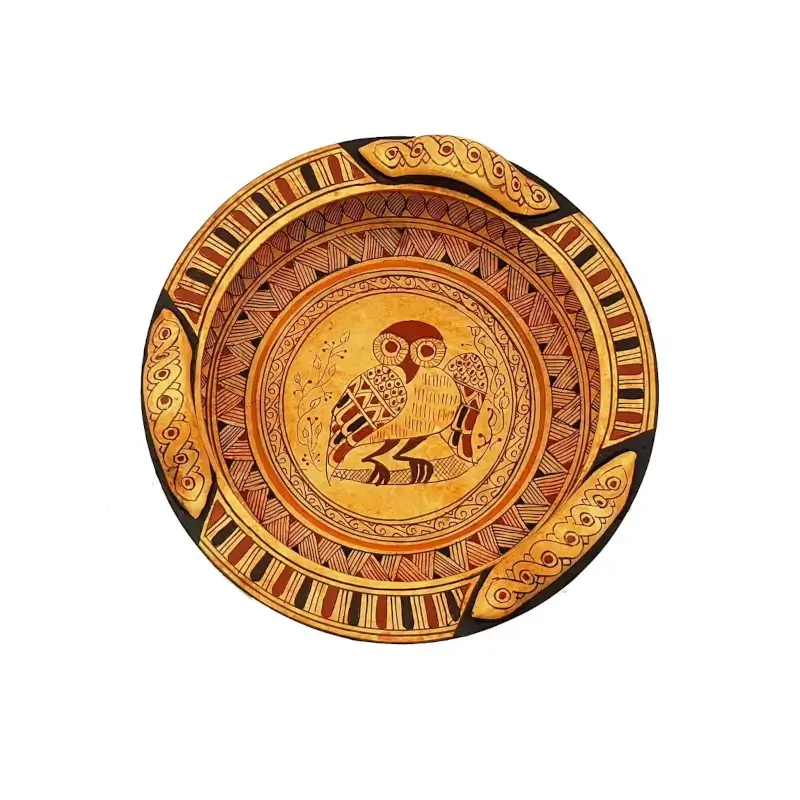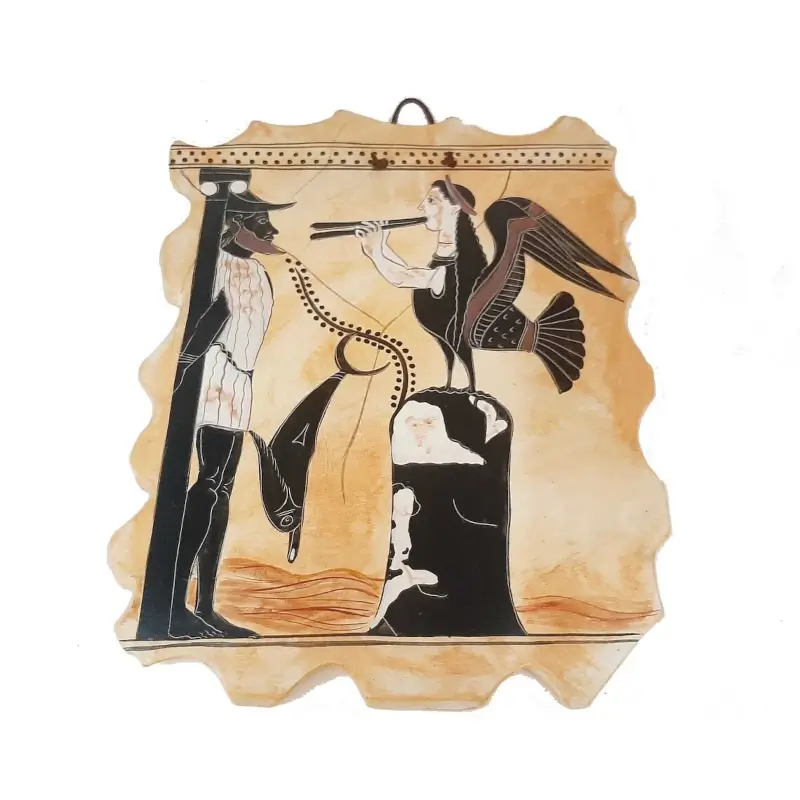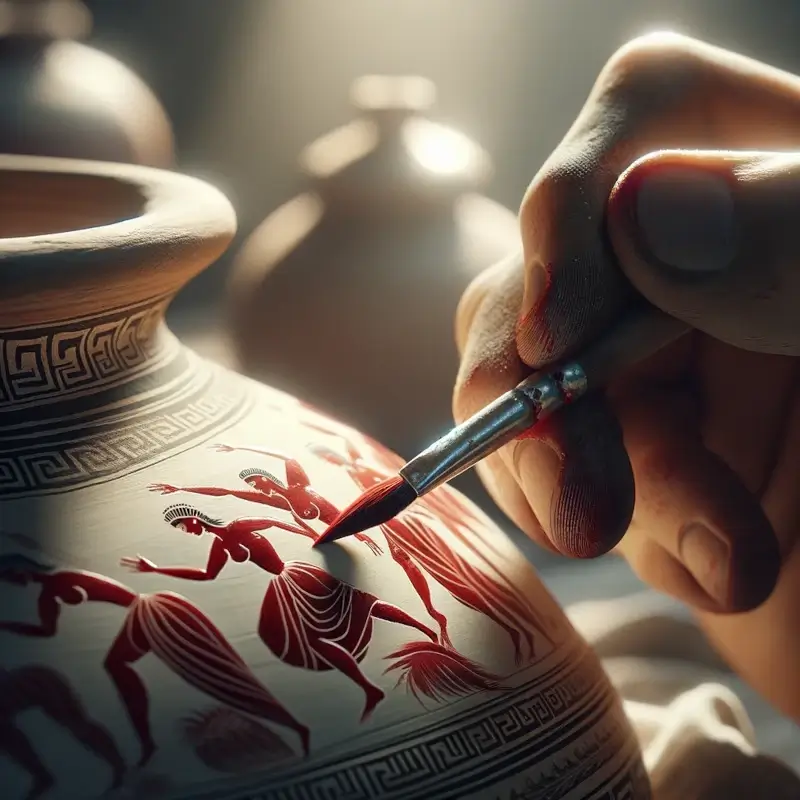The hypnotic geometric Greek ceramics
Greek geometric pottery, which developed from about 1000 to 700 B.C., is a manifestation of ancient Greek ingenuity and creativity.
Their shapes and decorations speak volumes about the advanced development of Greek pictography.
This style is characterized, as its name suggests, by the predominant use of geometric motifs, where circles, arches, and straight lines intertwine. If you are attracted to the mysteries of the past and the beauty of the simple turned into art, read on.

Why was geometric Greek pottery so beautiful?
The beauty of Greek geometric pottery lies in its perfect harmony between form, function and decoration, reflecting the ingenuity and creativity of ancient Greece.
This style, which became popular around 900 B.C., favored rectangular spaces in the vessel bodies, which were filled with bold linear designs, possibly influenced by basketry and weaving techniques.
One of the most iconic decorative elements of this era was the Meander design, which became an enduring symbol of Greece. In addition, the underside of the vessels was often painted black, creating a strong visual contrast that emphasized the complexity and precision of the geometric patterns.
During this period, the representation of human figures, birds and animals began to be integrated into the designs, covering almost the entire surface of the vessels with lines and shapes in brown and black tones.
Towards the end of the geometric period, the so-called orientalizing style gained popularity in Corinth, adopting stylized plant and animal motifs from the East, which further enriched the decorative repertoire of Greek ceramics.

Geometric pottery was not only aesthetically pleasing, but also served a practical and ritual function, especially in funerary practices, where the amphora and crater served as grave markers. This connection to burial rituals gave the vessels a deeper meaning and a constant presence in the daily and spiritual life of the ancient Greeks.
The technical development of ceramics during this period was remarkable, with the introduction of techniques such as red-figuring, which allowed for greater artistic expression by painting details with a brush, creating varied effects by thinning or thickening the liquid clay.
This advance not only improved the quality of the representation of human figures and clothing, but also allowed for the incorporation of inscriptions and greater complexity in narrative scenes. These elements together – the precision of the patterns, the symbolic richness, the technical advance and the integration of mythological narrative – make Greek geometric pottery an artistic manifestation of great beauty.
In the following sections, we will further explore the origin and development of this style, as well as the innovations that distinguished it.
Origin and development of the geometric style in Greek ceramics
The geometric style in Greek ceramics developed from the Mycenaean tradition and was characterized by its intensive use of geometric patterns, marking the beginning of the Greek artistic phase known as the geometric period, which lasted from approximately 1000 to 700 BC.
This period reflects the transition from Mycenaean forms to a more abstract and decorative style, distinguished by the total coverage of the surfaces of the vessels with fine patterns in which circles and arches predominate, as well as other motifs such as the meander, the checkerboard, the triangle, the fishbone and the swastika.
As the geometric period progressed, especially during its middle and late phases, a growing interest in figurative representation was observed. Although at the beginning these human and animal figures were very stylized and geometric, with time they began to acquire greater detail and realism, always maintaining geometric elements in their representation.
This evolution reflects a movement toward more naturalistic expressions within the confines of the geometric style. In addition, vessels from this period frequently served as grave markers or contained funerary offerings, underscoring the close relationship between geometric ceramics and the ritual and funerary practices of the period.

Buy unique Greek reproductions
Fortunately, there are artisans who make reproductions identical to the classical works of art that were made in ancient Greece and are only found in museums, making them affordable.
In terms of technique, this period saw the refinement of black-figure ceramics and, later, the introduction of the red-figure technique towards the end of the geometric period. The latter allowed for greater detail in the representation of human figures and clothing, which contributed to greater complexity in the narrative scenes that could be depicted on the vessels.
Greek geometric pottery, therefore, represents a crucial moment in the development of Greek art, marking not only an evolution in style and technique, but also reflecting significant changes in ancient Greek society and culture during this period.
Innovations in geometric Greek pottery: characteristics
One of the most outstanding innovations was the red figure technique, invented in Athens around 525-520 BC. This technique allowed for greater expression of detail through the use of a brush, achieving varied effects by thinning or thickening the liquid clay. This approach contrasted with the earlier black-figure style and allowed for more dynamic and detailed depictions of human figures, contributing to a richer visual narrative in ceramics.
The geometric style is also distinguished by its proto-geometric designs, which included precisely painted circles and horizontal lines, with vessel bases decorated with vertical triangular dots, a motif that would endure for centuries. By 900 B.C., the full geometric style favored rectangular spacing on the main body of the vessels, decorating it with bold linear designs, possibly influenced by contemporary weaving and basketry.

These innovations not only improved the aesthetic quality of ceramics, but also reflected changes in Greek society and culture, including greater narrative in depictions of popular myths and legends. The inclusion of more precise and vigorous detail in stylized figures marked the birth of the celebrated black-figure style, which would reach new levels of technique and quality, especially in Proto-Corinthian pottery toward the end of the 7th century BC.
The protogeometric period
The protogeometric period, which spanned approximately 1050 to 900 B.C., marked a crucial stage in the evolution of Greek ceramics after the collapse of the palatial Mycenaean-Minoan culture and during the so-called Greek Dark Ages.
This period represented the first manifestation of a civilization that was beginning to revive, characterized by significant technical advances, such as the development of a faster potter’s wheel, which allowed for greater technical perfection in vessel production compared to earlier examples of the Dark Ages.
The decorative motifs of this period were limited to purely abstract elements, notable for broad horizontal bands around the neck and belly of the vessels, and the use of concentric circles applied with compasses and multiple brushes, among other simple motifs. Unlike later styles, many surfaces of protogeometric ceramics were left undecorated.
The pottery of this period introduced some new forms influenced by the Mycenaean style, such as the amphora with handles on the belly, the krater, and the lekythos. Attic artists redesigned these vessels using the fast wheel to increase their height and thus the area available for decoration. From Athens, the style spread to several other centers.
The artists and potters of the Proto-Geometric period began a transition to more naturalistic styles, especially in the middle and late stages of the Geometric period. This transition included a growing interest in figurative representation, although at first these figures were highly stylized and geometric.
Over time, the representations became more detailed and realistic, although always maintaining geometric elements in their representation. The inclusion of more precise details in the stylized figures marked the beginning of the famous black figure style, which would reach new levels of technique and quality.
Geometric period
The geometric period, which extended from 900 to 700 B.C., was characterized by a marked preference for geometric shapes in the decoration of ceramics, which gave this period its name.
This style emerged at the end of the Dark Ages in Greece and was distinguished by its use of geometric patterns to represent human and animal figures, as well as abstract decoration. Horror vacui, or the fear of empty space, was a common technique, filling every surface of the vessels with images, meanders, broken lines, circles and swastikas, following a uniform graphic concept.
During the geometric period, especially in its late phase, there was an evolution towards more naturalistic expressions in ceramics, with a decrease in tragic themes and greater freedom in geometric forms. Areas with animals, hunting scenes, shipwrecks, and mythological or epic themes such as those in Homer’s works began to predominate, leading geometric ceramics towards more naturalistic expressions.
Vessels in this style are characterized by horizontal bands covering the entire vessel, and between these lines, geometric artists used a variety of other decorative motifs such as the zigzag, triangle, meander and swastika.
In addition to abstract elements, painters of this era introduced stylized depictions of humans and animals, marking a significant departure from the earlier Protogeometric style. Many of the surviving objects from this period are funerary objects, particularly amphorae that acted as grave markers for aristocratic burials.
This period was fundamental in the development of Greek art, not only for its aesthetic and technical characteristics but also for what it reveals about the society and culture of the time through its funerary practices and the symbolism in its art.





